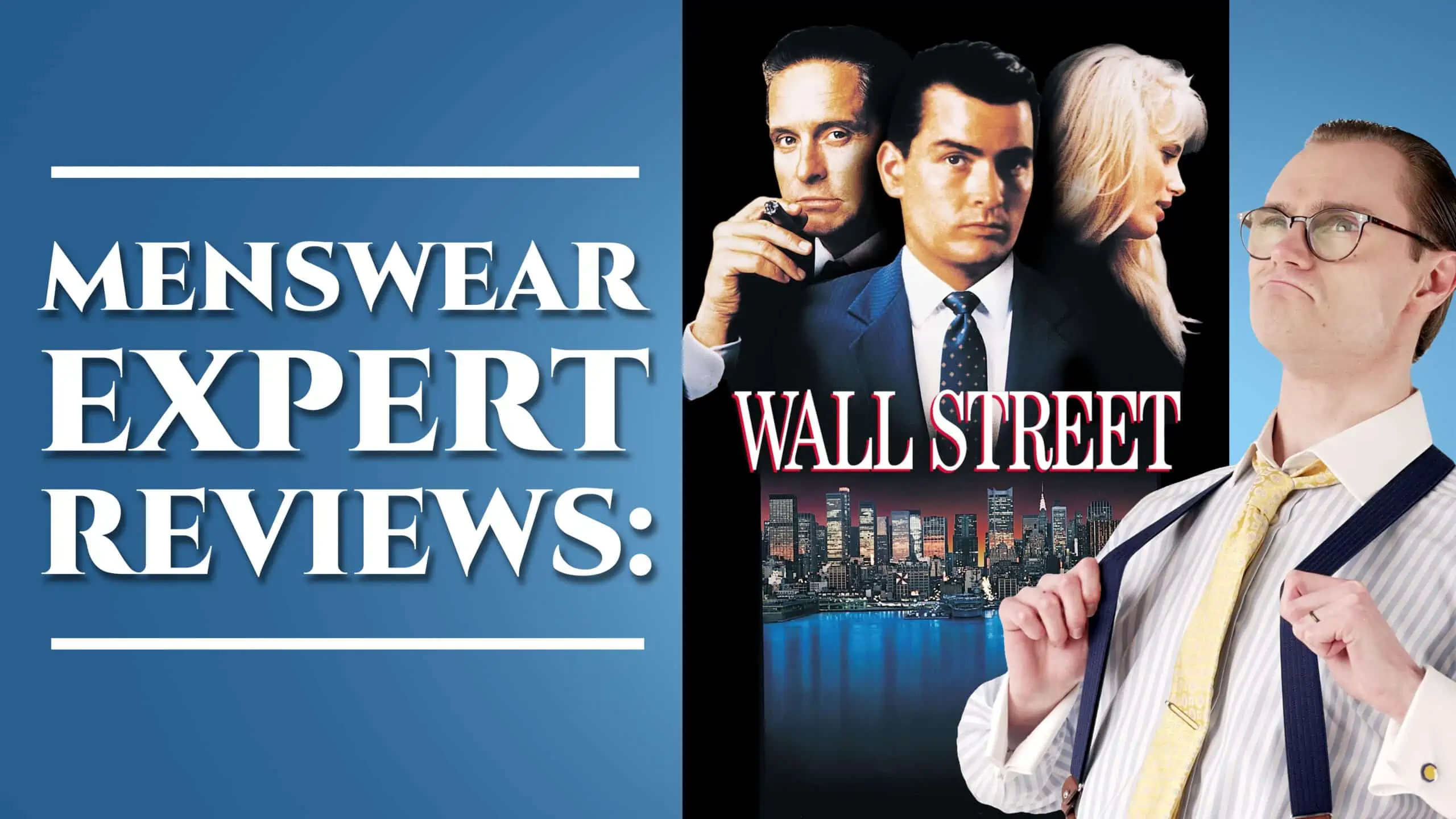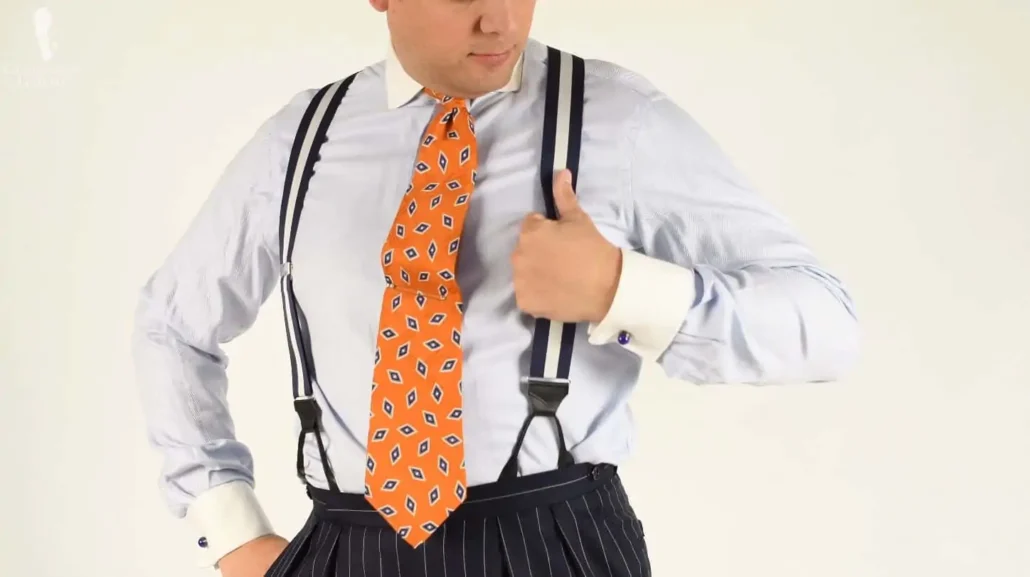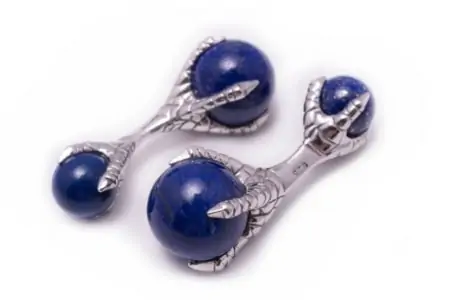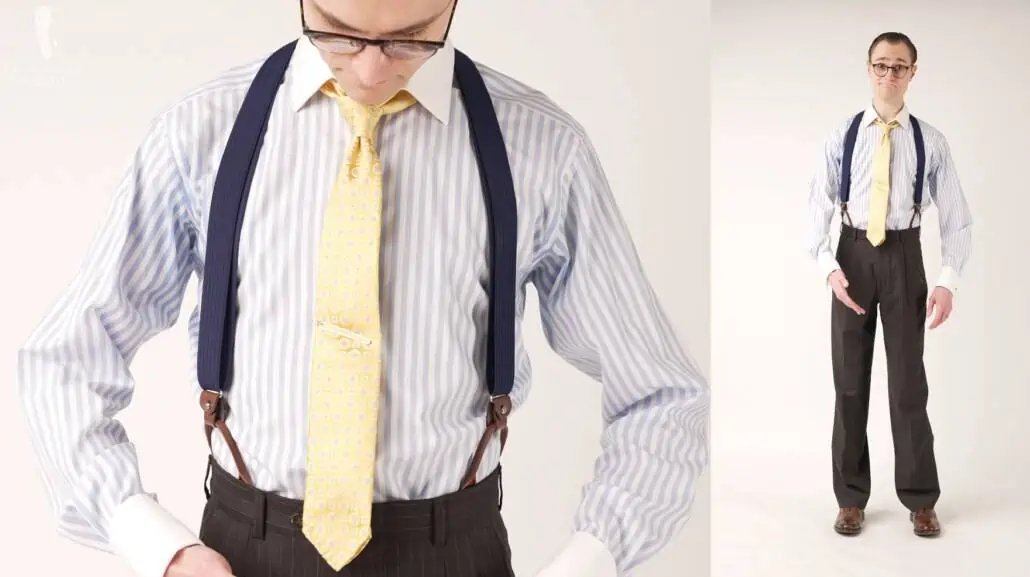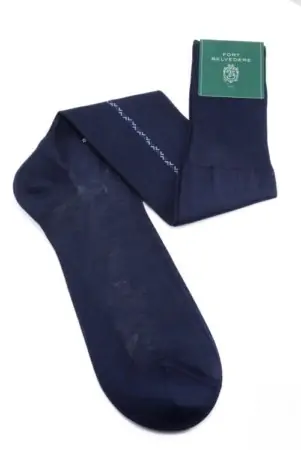On top of its compelling plot, the 1987 film Wall Street is also well known for the bold clothing worn by its characters–clothing that inspired themed parties and Halloween costumes, and even impacted the style of actual Wall Street brokers! So, how accurately did the movie depict the office wear of the 1980s, and what trends did it initiate? Let’s take a closer look!
While we won’t specifically be going too in-depth on the plot, note that there will be some spoilers in today’s post, in case you haven’t seen the film yet. Unlike most of the films we’ve covered in this series so far, which typically cover time periods far before the films themselves were actually made, there isn’t that much of a gap in today’s case.
The film was made in 1987 but depicts events happening in 1985. But, of course, this is still a Hollywood film we’re talking about. So, the costume designers were going for a particular look that wasn’t necessarily reflective of what men were actually wearing at the time in most cases.
Still, the looks depicted in the film did become iconic in their own right, inspiring Halloween costumes and costumes for fancy dress parties for years to come and did even impact the fashions on the real Wall Street.
Costume Design (and Designers)
Ellen Ellen Mirojnick is credited as the costume designer for the film and, indeed, she’s worked on many movies from the 1980s up to the present day. We should also note though that menswear icon and author Alan Flusser was heavily consulted for the wardrobe of the film, particularly when it came to the character of Gordon Gekko.
Some sources have even claimed that almost a fifth of the film’s total clothing budget simply went to Michael Douglas’ clothes as Gekko. And celebrated craftsman, Alexander Kabbaz, was responsible for making Douglas’s shirts.
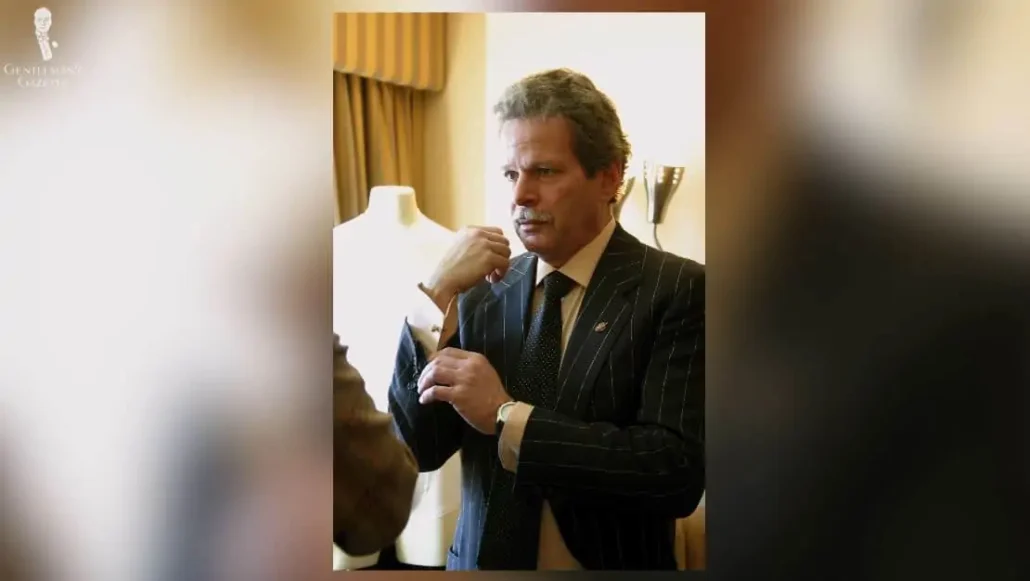
In designing the costumes of the film, Flusser and Mirojnick were clearly inspired by the high-end fashion looks worn by powerful financiers of the day like Asher Edelman, Carl Icahn, Jeff Beck, T. Boone Pickens, and Ivan Boesky, among others.
But, of course, the looks for the film overall were bigger, bolder, and brasher than what many men working on Wall Street were actually wearing at the time.
Alan Flusser was a major tastemaker among menswear circles during this time, creating looks that were inspired by the 1930s, but with modern sensibilities or, at least, modern for the time. By the way, Raphael had the good fortune to visit Flusser’s atelier back in 2012, which we made a post about.
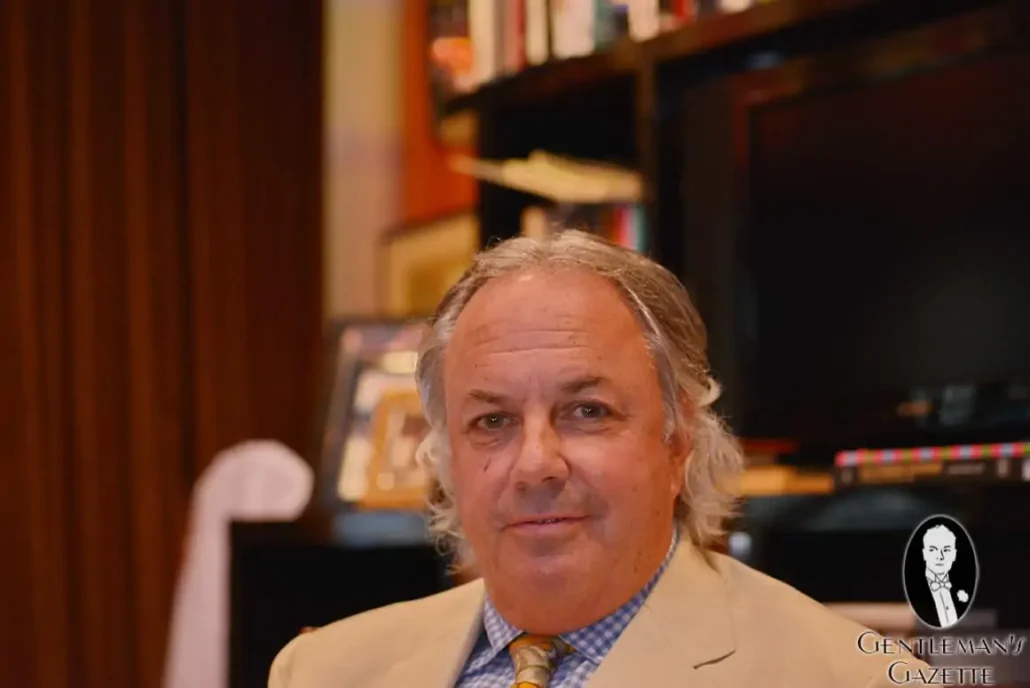
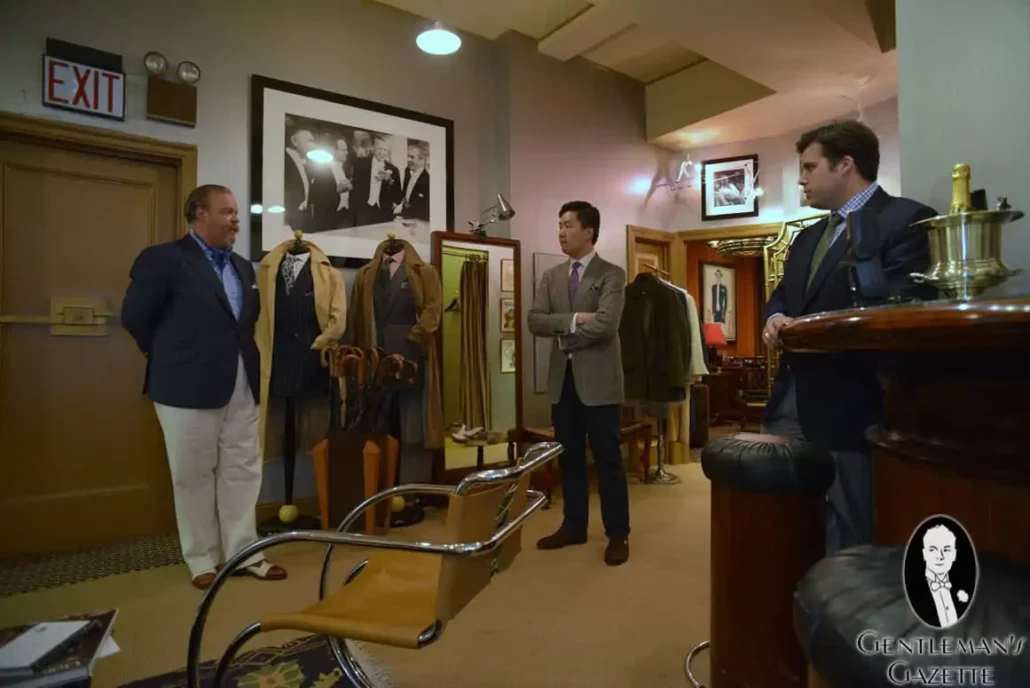
Broadly speaking, menswear in the 1980s was undergoing a bit of a reorientation. This is evidenced in things like bold solids and striped patterns replacing the organic patterns of the 70s in shirts, relaxed lines and wider cuts for suits more reminiscent of sack suits), and the overall slimness of the late 60s and 70s replaced with more volume. Indeed, these voluminous, almost baggy looks would come to be known as power suits.
Showing the cycle of imitation between art and life, Flusser took looks that were popular at the time and exaggerated them to the nth degree when creating costumes for the film. But, then, when the film became popular, those looks began to be seen on men in real life. Phrased another way, the film defined more than it depicted the Wall Street look of the 1980s.
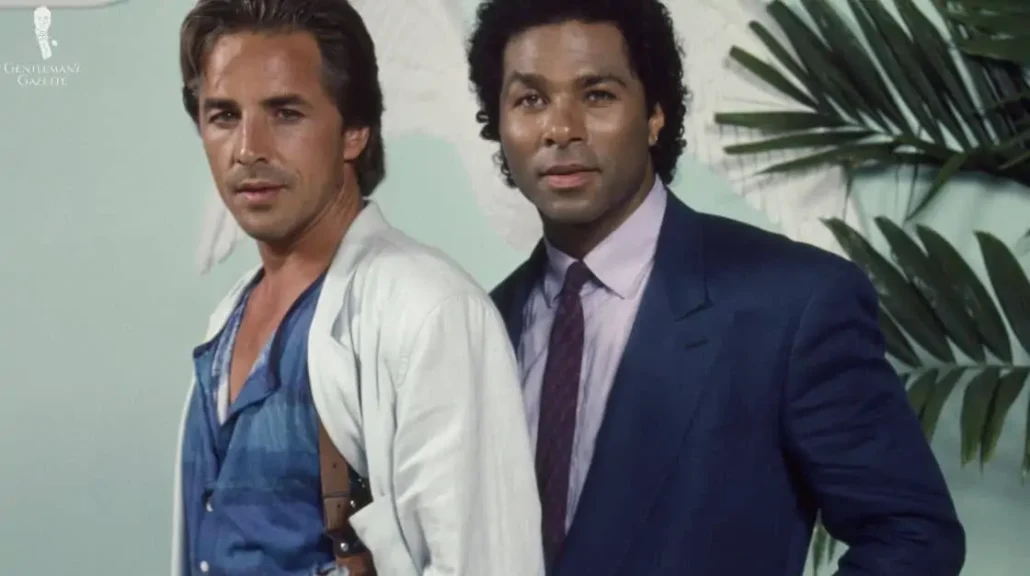
So, then, should you go out and buy your own Gekko shirts, or should the looks of this film be left to go the way of piano key neckties and powder blue tuxedos? Well, as Gekko himself said, “the most valuable commodity I know of is information.” So, let’s find out.
A Review of Wall Street‘s Characters – Gordon Gekko (Michael Douglas)
Gordon Gekko, the antagnist, is a self-made man who showcases his success through sartorial style. He intentionally bends many fashion rules and pulls off looks that would be too bold for many offices of the time. But, not only can he get away with wearing these bolder colors and patterns because he is the boss, but, he also knows enough about style to wear it with confidence and panache.
The broad-look power suits of the 1980s did exist before this film, but the character of Gordon Gekko cemented their popularity.
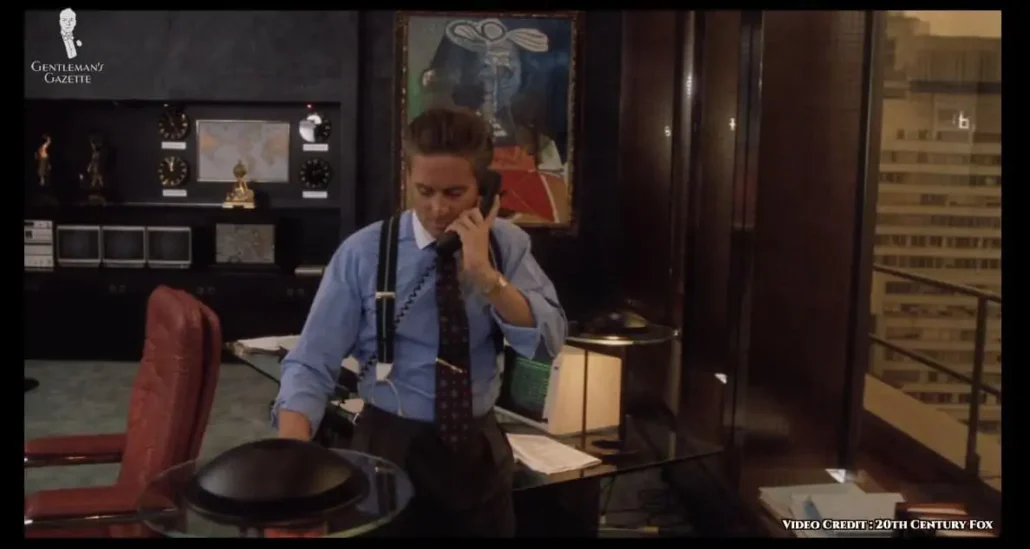
When we are first introduced to the character in the film, he’s not wearing a jacket, but we can see his full-cut pleated trousers. They’re charcoal in color with a generous fit and a perfect drape.
The power suit look was all about appearing large and in charge. And, indeed, this is why we see more looks of full suits in the 1980s as opposed to combinations, as one mass of a solid color makes a figure look more imposing overall. Odd combinations did exist in the 1980s, of course, but they weren’t the dominant or fashionable look.
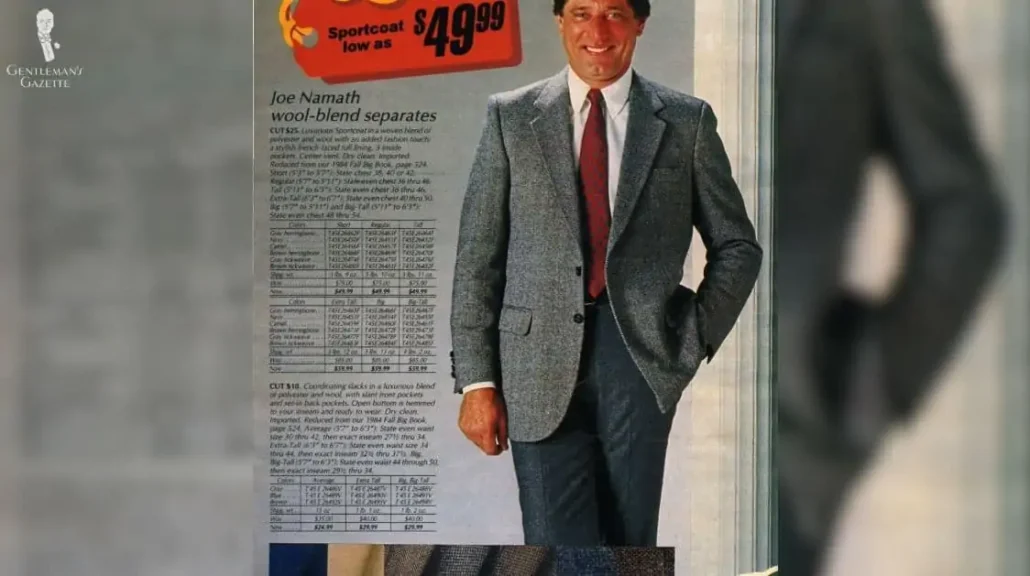
Gecko doesn’t just go big, he also goes bold. The contrasting spread collar of his Winchester shirt provides visual interest and draws a viewer’s eyes to his face and, while Winchester shirts weren’t invented in the 1980s, they were very popular during this decade.
Similarly, suspenders or braces were also popular at various points in the 20th century, but had a big resurgence in the 80s and, indeed, they’re another part of the iconic Gekko look.
We can see Gordon Gekko in various pairs of suspenders throughout the film, including a two-tone blue pair, a cerulean pair, and a dark navy pair with white polka dots. Loud and colorful suspenders were also popular in the 80s, and we can see Gekko wearing plenty of those, too.
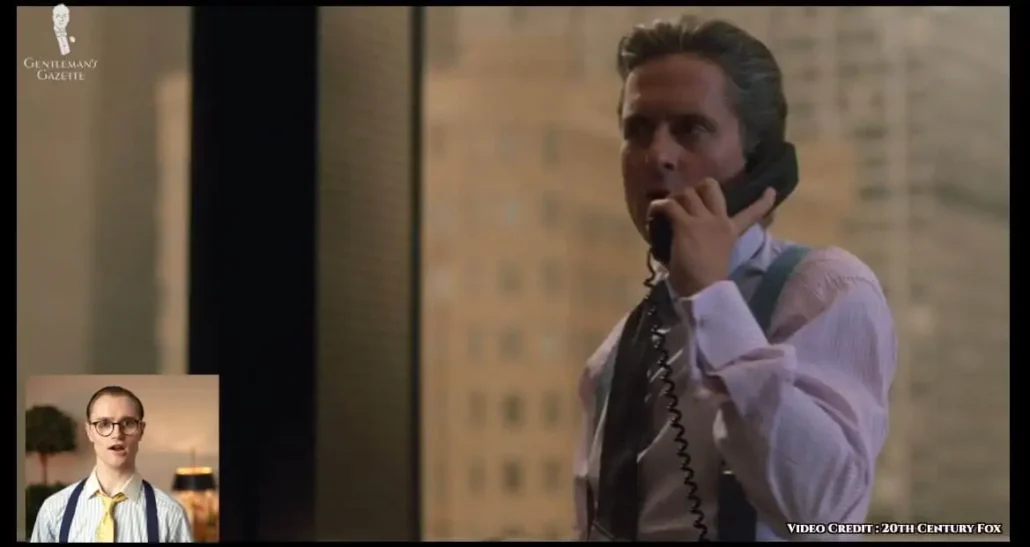
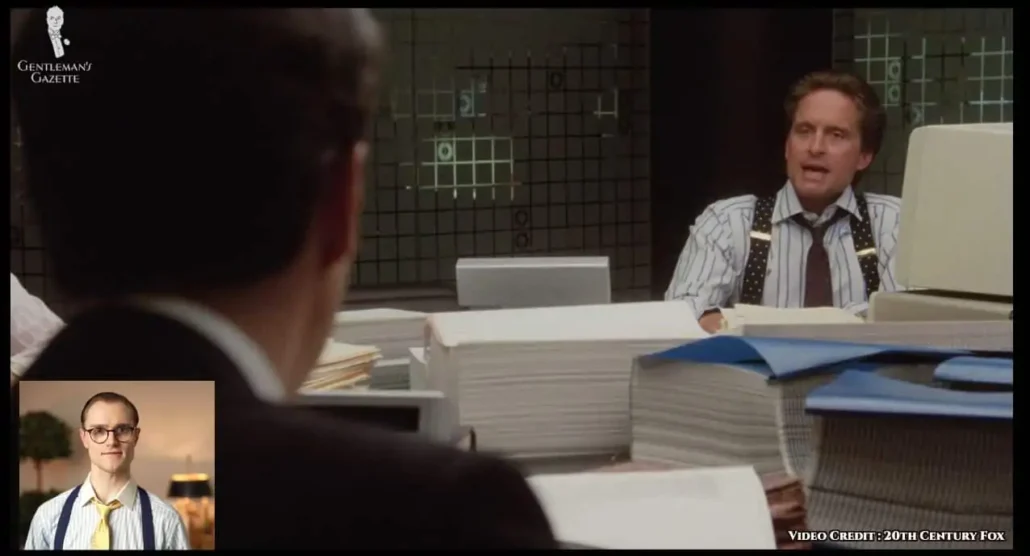
We often see Gekko, as well as many of the film’s other characters, in their shirt-sleeves, which speaks to the rolled-up sleeves work ethic of the time. It’s also likely a concession to comfort as well. Still, during important events or meetings, characters do often keep their jackets on.
The first tie we see Gekko wearing, in a plum color with a fairly busy polka dot and medallion pattern, is on the bolder side, at least compared to the more conservative striped ties that were actually popular at the time. Still, more decadent ties, which had been popular in the 70s, would hold over into the 80s as well, like these ties from Hermes, for instance.
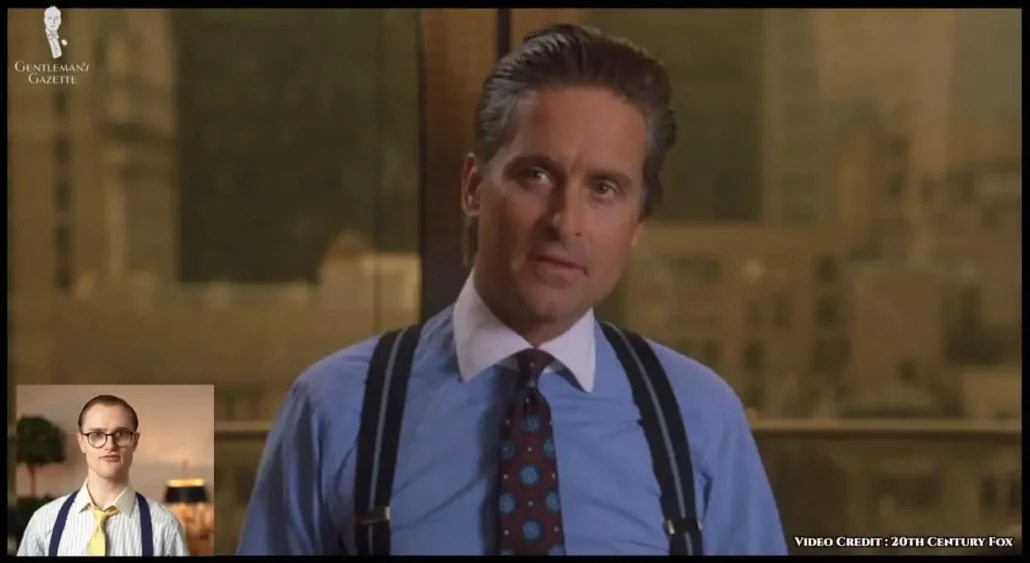
In terms of jewelry, Gekko gets a zing from various gold accessories, such as a signet ring, bracelet, and watchband. Rings would definitely have been seen as a statement piece in the 1980s, but they certainly weren’t unheard of. And if you’d like to learn more about how you can pull them off, you can take a look at our jewelry guide.
Gekko’s watch here is a Santos de Cartier, which would have been a popular choice for men looking to show off a bit, even if they were somewhat budget-conscious.
Later on in the film, we can also see Gekko wearing what appear to be Cartier Vendome sunglasses.
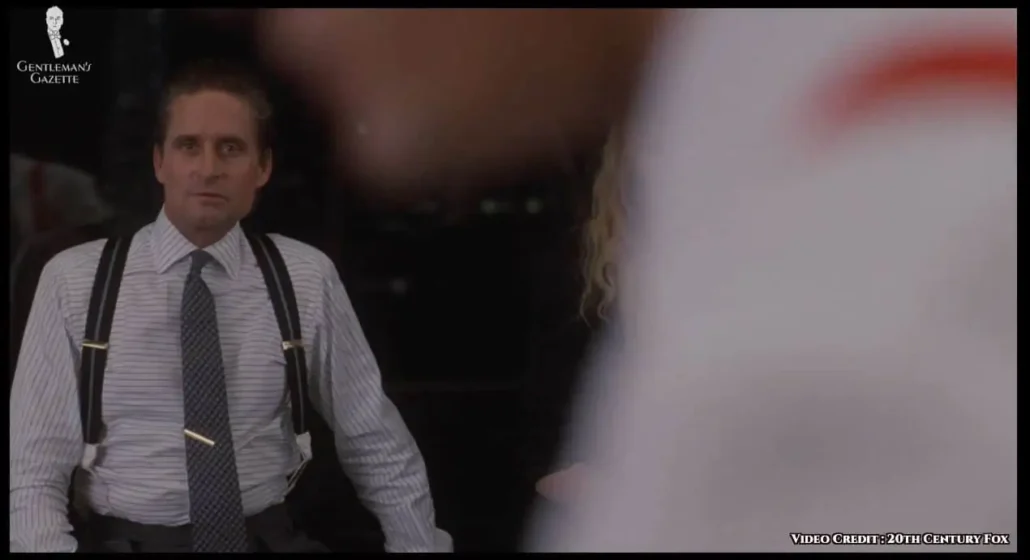
Gekko also usually wears a tie bar or tie clip, often at a rakish angle, perhaps going for a bit of a sprezzatura look. This casual, yet bold style probably wouldn’t be appropriate for most offices, but, again, Gekko wears what he pleases.
The typical “Gekko Look”
Subsequent outfits that we see further illustrate the Gekko look, in particular, featuring Winchester shirts with striped patterns, which are sometimes even called “Gekko shirts.” The stripes serve to make him look taller and the flared, often peaked lapels on his jacket serve to broaden his chest, both popular tricks in 80s dressing.
And, late in the film, when it’s revealed that Gekko has betrayed his protégé, Bud Fox, we see him in a look that is both iconic Gekko and, indeed, iconic Alan Flusser.
He wears a generously-padded, single-breasted suit in a taupe color with peak lapels, along with a red and white, checked Winchester shirt with a club collar, a relatively conservative dark red and slate gray tie, which contrasts heavily with the shirt, but still works harmoniously overall.
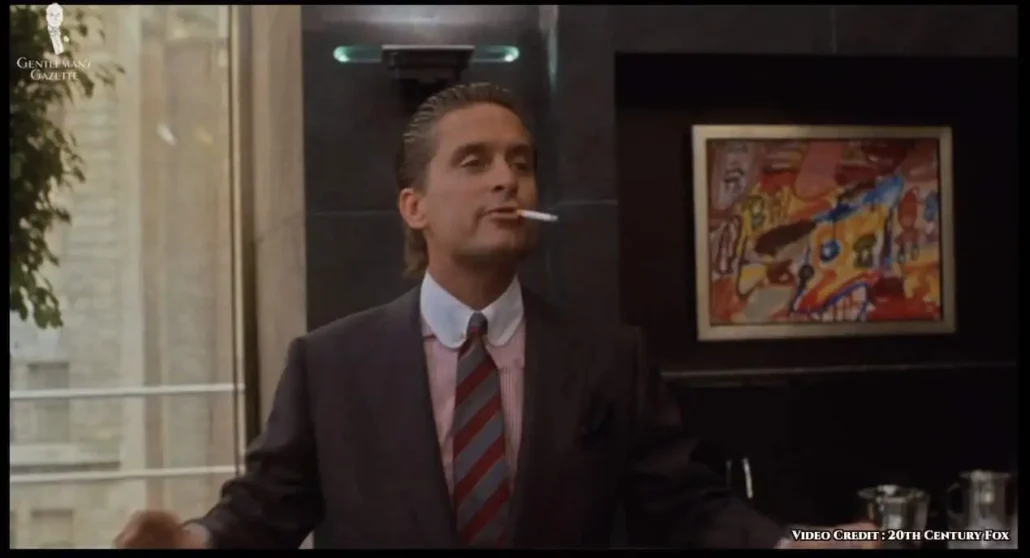
The shirt, especially given its club collar, speaks to another source of inspiration for the clothing in the film: the Edwardian Era. As you’ll find out in the 1910s installment our What Men Really Wore series, features like unusual or bold striped patterns, vibrant earth tones, and rounded contrasting colors and cuffs were common features of early 20th Century menswear.
Gekko compares himself to early captains of industry like Andrew Carnegie or Andrew Mellon, and, indeed, he may be taking a bit of sartorial inspiration from them as well.
Other unusual styles that we see Gekko sporting include horizontally striped shirts like this one in gray and white and suit jackets that feature turn-back or gauntlet cuffs at the ends of the sleeves. These turn-back styles were popular in the 60s and 70s and were often seen on high-end or custom suits as a subtle symbol of status.
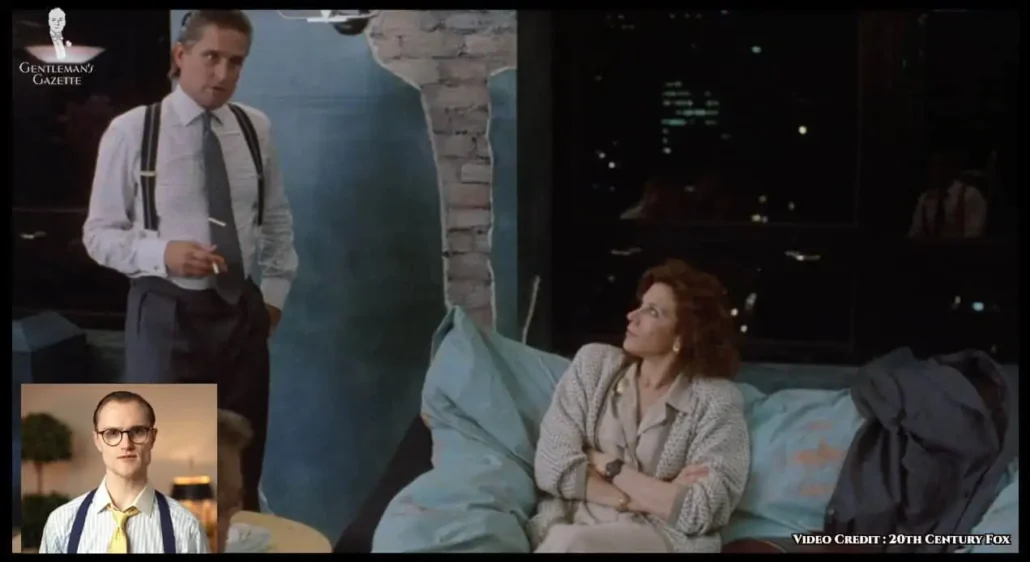
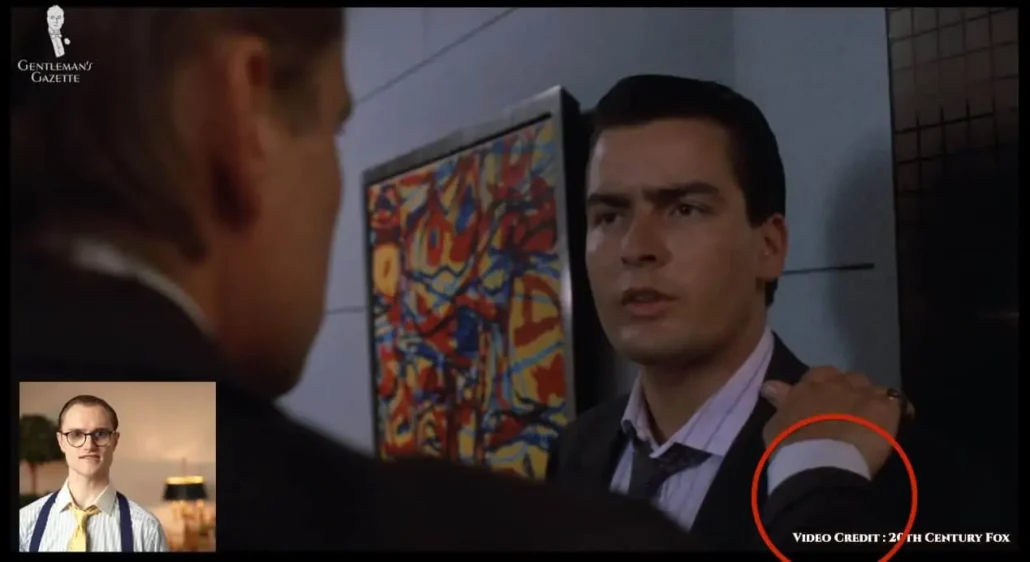
Returning to that iconic look we mentioned before, flash is added through more gold jewelry, such as the high-shine cufflinks and collar pin.
When it comes to cufflinks, Gekko runs the gamut from more sedate gold and onyx options to more opulent varieties.
Of course, he can tone things down a bit as well and, as an example here, while attempting to assuage the fears of a mostly older and more conservative group of stockholders during his infamous “greed” speech, he wears a conservative dark navy suit with a white spread-collared dress shirt and white pocket square in a simple banker’s fold, along with a plain tie bar and simple square cufflinks.
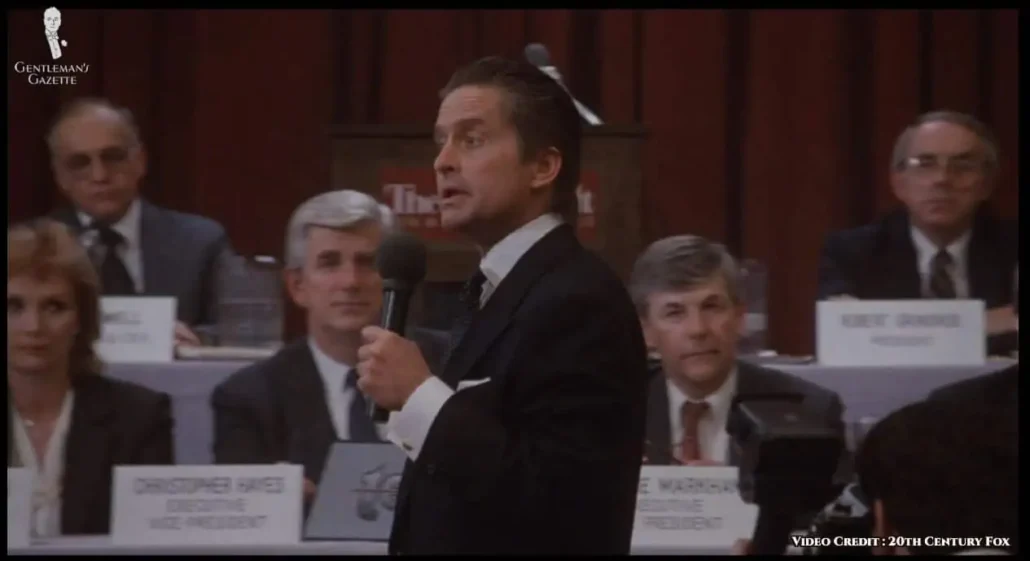
It’s clear that Gekko is a man who knows his cufflinks as he’s opted for a variety here that has decoration on both sides rather than a simple toggle. This is the ideal in cufflinks and it’s why all of the models we offer in the Fort Belvedere shop are double-sided in nature.
Gekko’s Toned-Down Style
Gekko’s more subdued look here is probably inspired by the looks of politicians and bankers of the time to create an image of dependability and trustworthiness. So, Gekko can set aside his trademark flash when he needs to, such as in this scene when we see him wearing a waistcoat, indicative of a three-piece suit like ones that are worn by other characters as well.
Gekko can also be more casual as we can see during this dinner party scene, when he wears a very light bluish-gray, four-on-two, double-breasted jacket with white trousers and a black shirt with no tie.
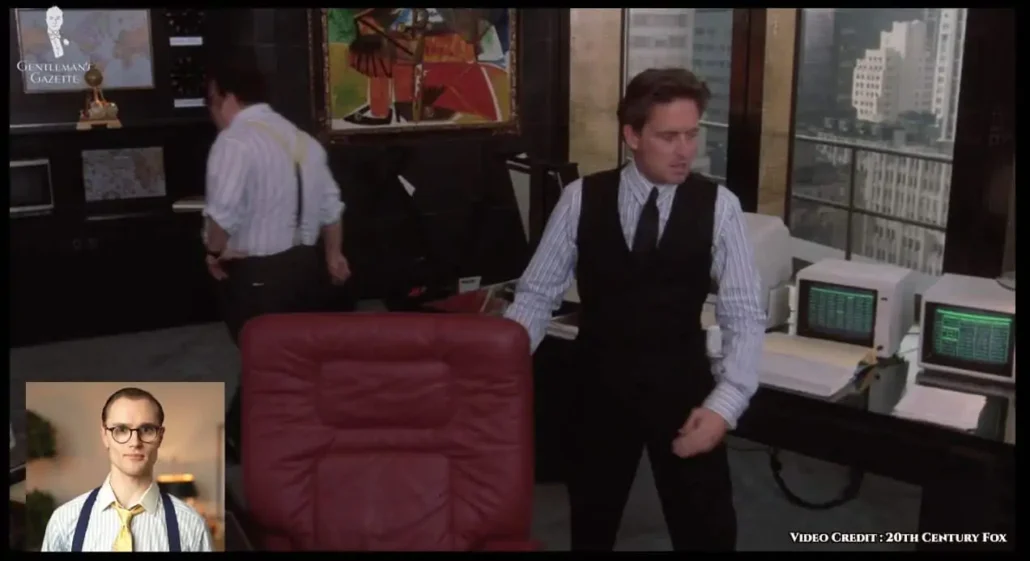
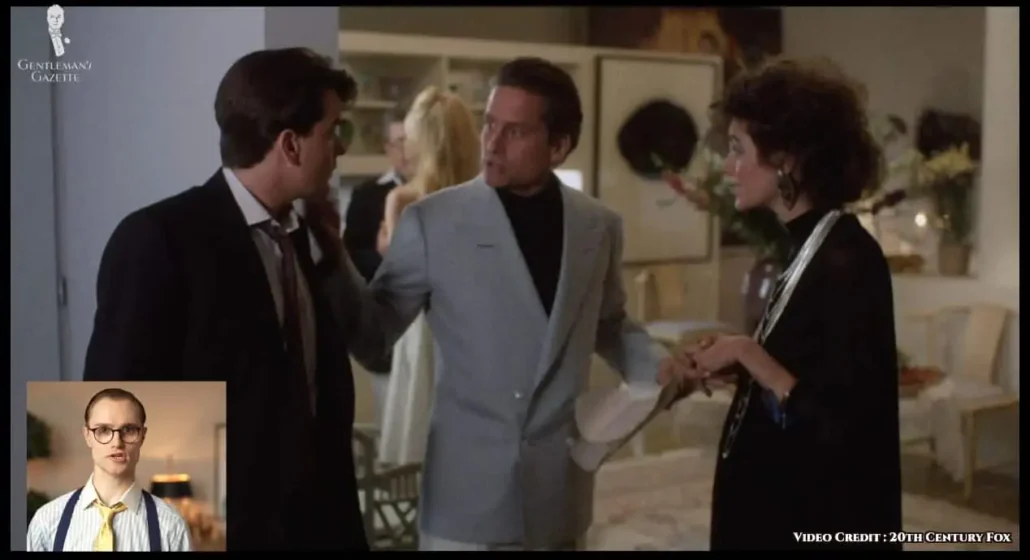
We also get a brief glimpse of his shoes here, which appear to be two-toned and are possibly spectators. This comfort-oriented domestic wear was typical of the casual yuppie, featuring rich luxurious fabrics in simple arrangements, especially while at home. For another example of this, albeit a less stylish one, we can see another party guest wearing a polo shirt under his jacket.
And, finally, even for all of his personal faults, Gekko does still understand that athletic wear should stay within the confines of the gym. While the 80s did see the introduction of athleisure into daily wear with things like tennis shoes, white socks, and athletic shorts, they were mostly seen in gym settings, like here on the racquetball court, and less so out in public.
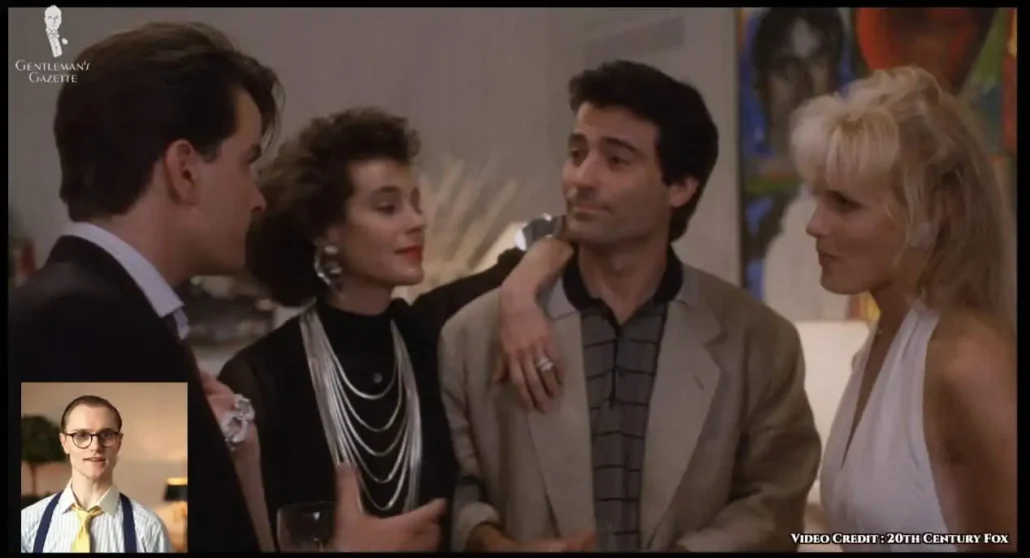
Overall, Gordon Gekko’s style is indicative of what only the most fashion-forward of Wall Street figures would have worn at the time. His looks definitely serve to highlight his independence, ambition, and shock-and-awe tactics.
Bud Fox (Charlie Sheen)
The protagonist of the film is Bud Fox, played by Charlie Sheen. When we first meet Fox, he’s an up-and-coming, gifted stockbroker from a blue-collar background, who wants to make it into the big leagues of finance, but is currently stuck in the minors.
As we meet him, he’s wearing a gray single-breasted suit with notched lapels, a light blue, vertically-striped, button-down collar shirt with a breast pocket, and a yellow tie with repeating blue medallions with a simple geometric tie tack.
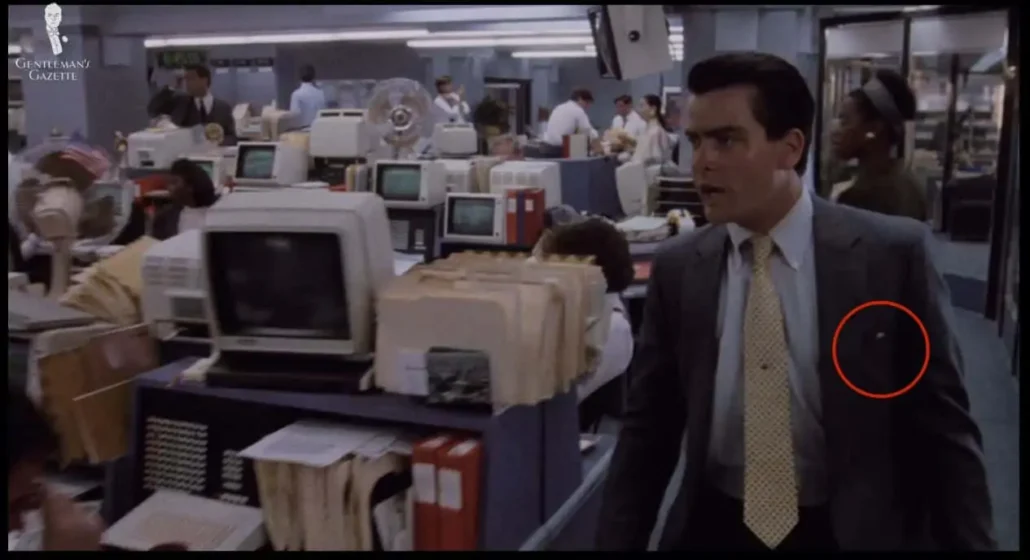
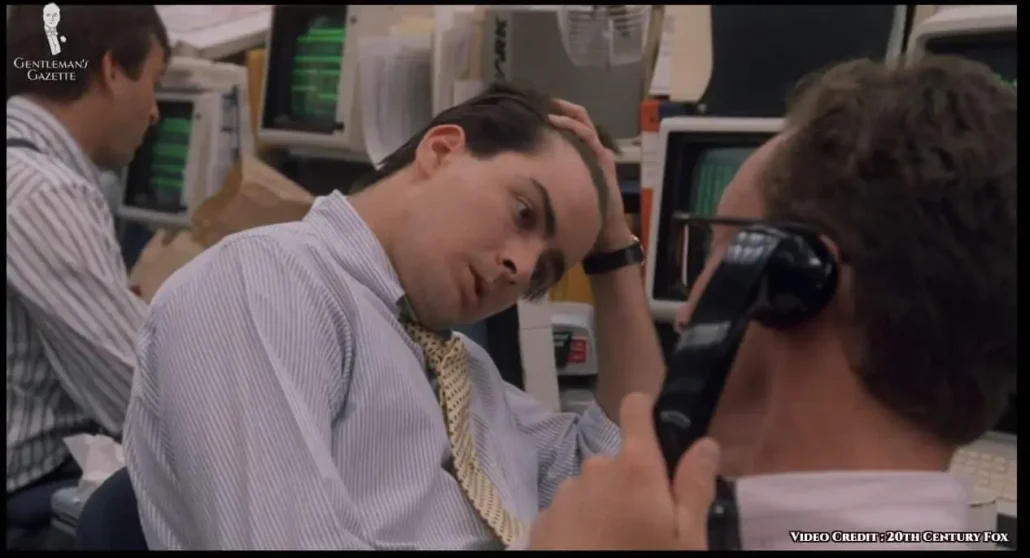
We’ll also see him wearing different tie tacks later in the film and, indeed, these were a fairly common accessory of the time. His outfit is completed with a relatively limp-looking white pocket square in a pointed puff fold.
Bud Fox’s Typical Office Looks
Fox’s entire ensemble here is relatively typical of the 1980s white-collar office worker with its overall conservative choices. And if you’d like to see how depictions of office wear in TV and film have evolved, we round up what they got wrong on Mad Men in the prior installment of our this series.
Fox mentions that his typical suits around this time cost him about $400, which would be around $1,000 in today’s money. It’s clear though that these early suits have little style and, indeed, don’t suit him very well at all.
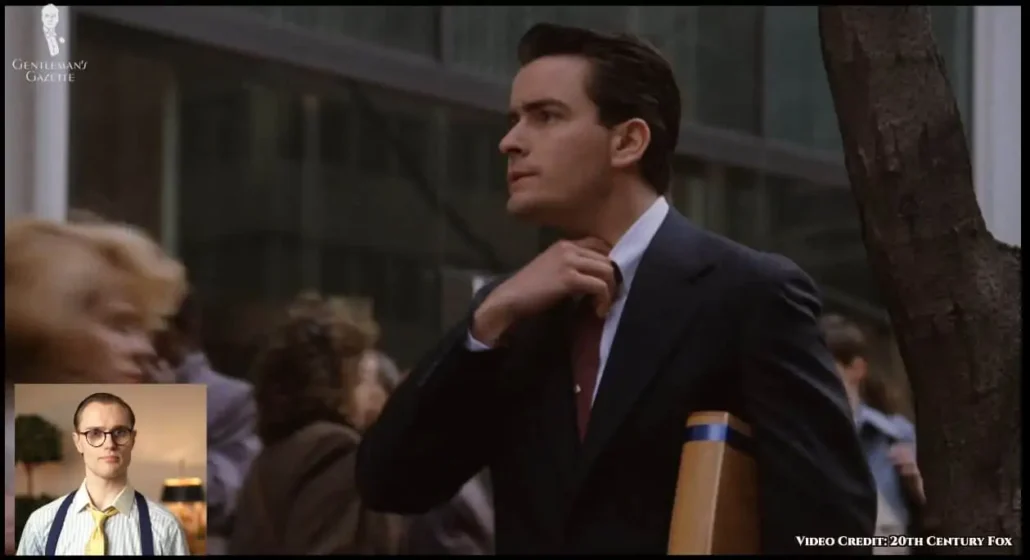
The high gorge and the lapel width aren’t optimized to his own proportions and don’t frame his face well and the fabric is lank and clingy. In fact, these mass-market, ill-fitting suits are something that the film gets very right, as these were dominating the market at the time.
Quality menswear was starting to make a comeback, but much of what the typical man would see on offer would be cheap suits or fashion labels peddling inferior products. Of course, this problem has only gotten worse today, but it was already known by the 80s.
When Fox wears a similarly-styled suit in a taupe color with an earth-tone check tie, Gekko tells him exactly what he should do with it: “And buy a decent suit. You can’t come in here looking like this. Just go to Morty Sills. Tell them I sent you.”
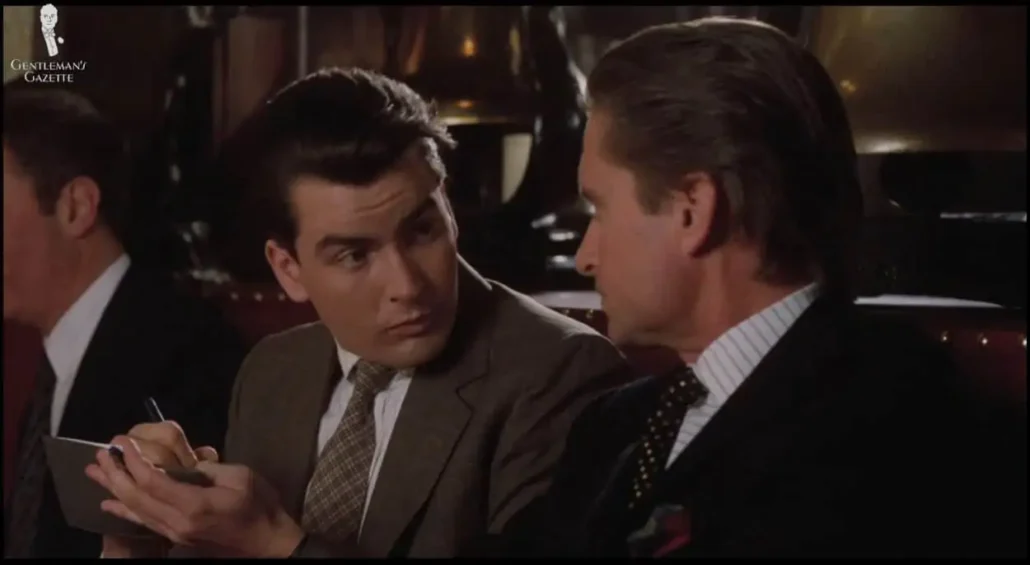
Fox also makes some other mistakes as well, including pulling a business card out of his suit’s exterior breast pocket, where, instead, these cards should be kept internally and this pocket should be left to pocket squares.
He does better with timepieces, though, as we see him wearing a Lorus dress watch with a gold case and a dark brown leather band. Lorus, by the way, is a subsidiary of Seiko founded in 1982.
Unlike Gekko’s Santos, for example, this watch would have cost closer to $100 than $1,000 at the time, and it shows off the principle that watches don’t necessarily have to be expensive in order to be visually attractive. On that note, we have a guide to the best watches under $100, which you may consult for your next classic budget watch purchase.
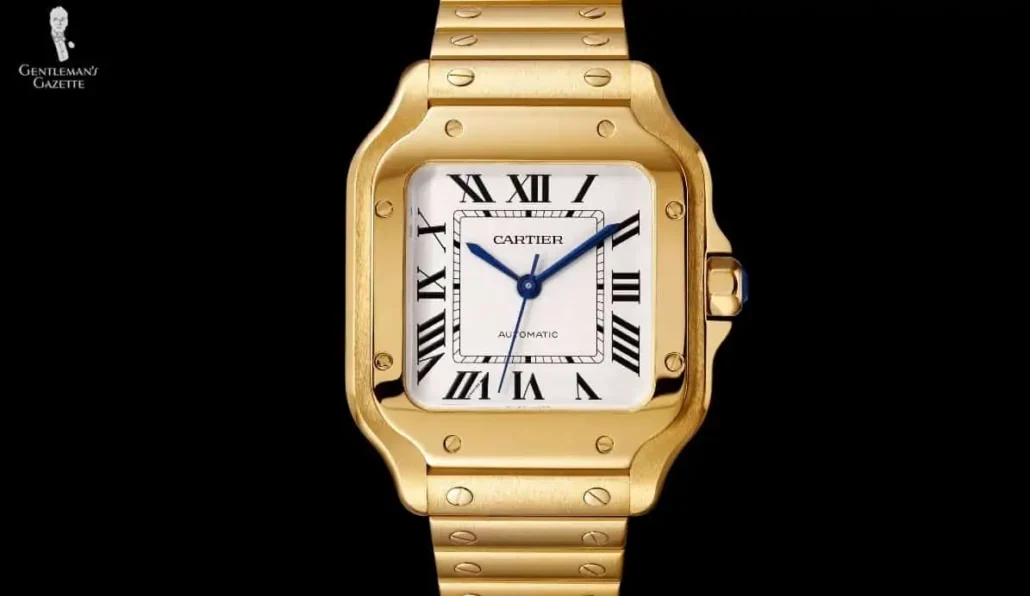
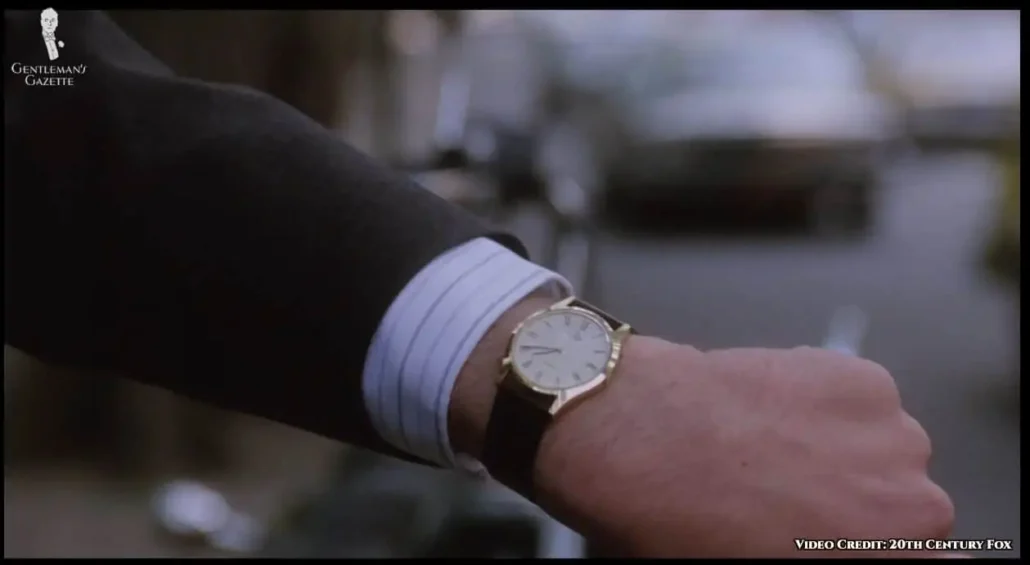
Lorus was Seiko’s attempt to break into the high-end watch market. It reflects Fox’s status and was typical of what a man on his salary could have afforded at the time. Like Fox himself, his personal style has potential, but it isn’t quite there yet.
Fox Imitates Gekko’s Style
After becoming a member of Gekko’s entourage though, Fox’s style gets an upgrade. We next see him wearing a gray double-breasted suit, a pink shirt, and a purple and blue silk paisley tie. The details of the ensemble, such as the peaked lapels or jetted pockets of the suit jacket, represent a step up in formality, but were still acceptable for office dress of the time. Indeed, even the pink shirt was a known commodity during the 80s.
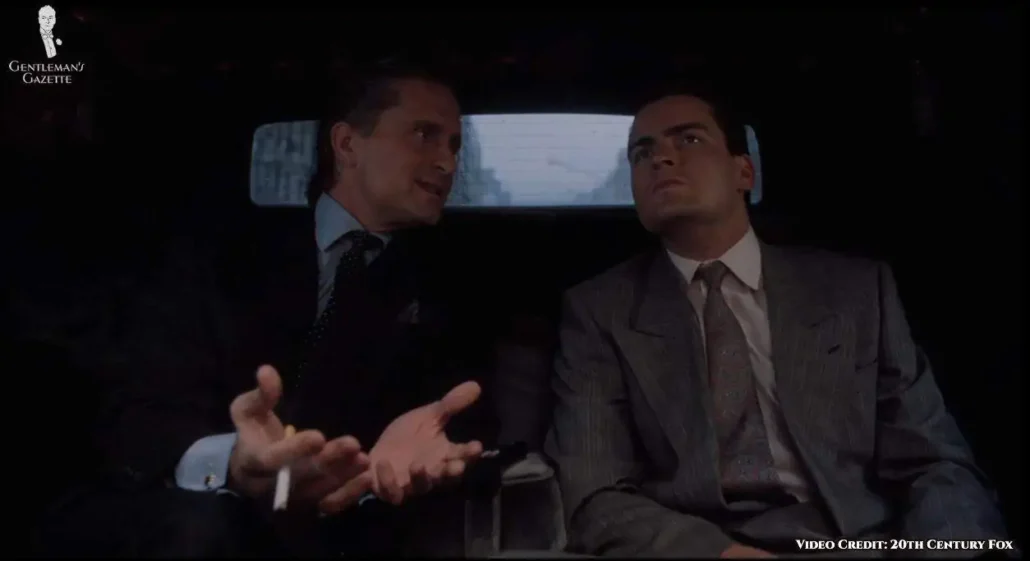
Soon, Fox is more explicitly imitating Gekko himself, including his propensity for Winchester shirts. Fox also begins wearing club collar shirts like Gekko, as well as suspenders to mixed results. Fox’s suspenders can then be seen in colors like navy, bright red, and this novelty bull and bear pattern.
Suspenders are a menswear article with both a practical and an aesthetic component. They’re primarily intended, of course, to functionally hold up one’s trousers, but they can also have a decorative element, especially to be worn in situations where one’s jacket might be removed.
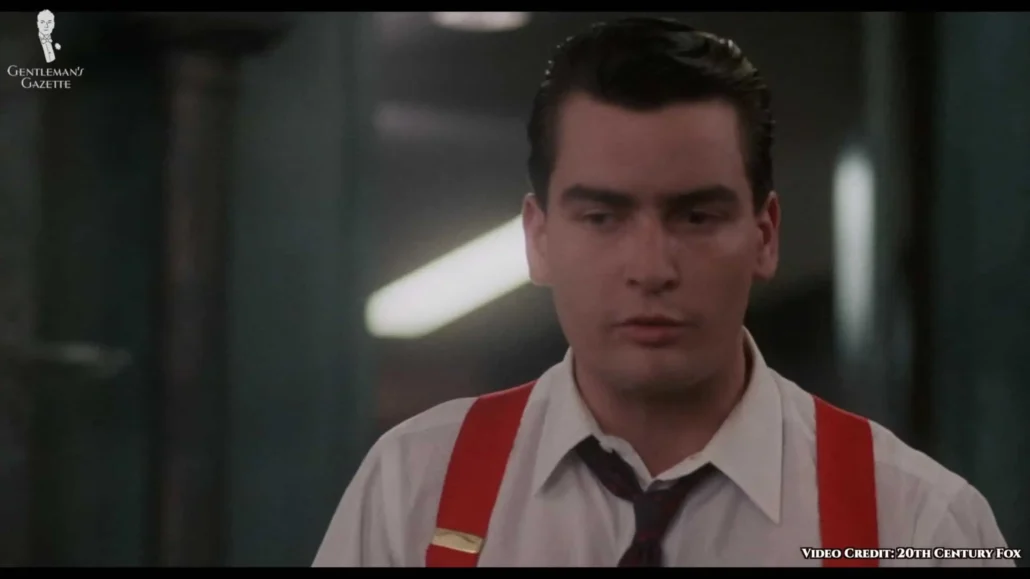
Some suspender looks can be loud, distracting, and not entirely classic, but we can’t fault the film for including them, as the 80s was in the middle of a kitsch craze of various components that featured loud and bold patterns. These novelty items were intended to add some levity to stuffy office environments and, clearly, Gekko and Fox also use them to command attention.
While under Gekko’s tutelage, Fox also favors bold ties, like a silk model in blues and greens or this red model featuring triangles in various shades of blue. Also, Fox will often try to coordinate the colors in his outfits, such as between his tie and pocket square or between his tie and his suit.
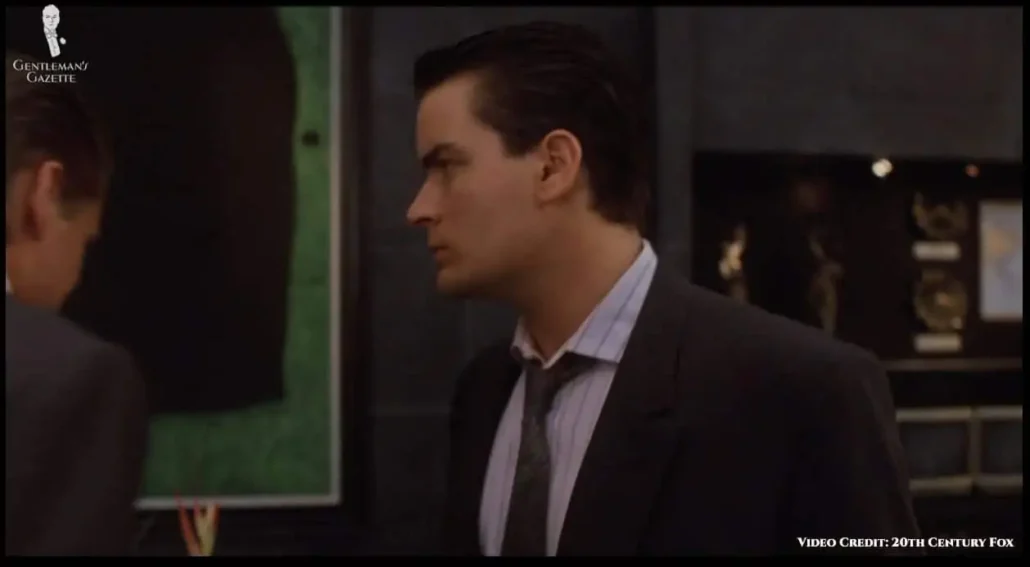
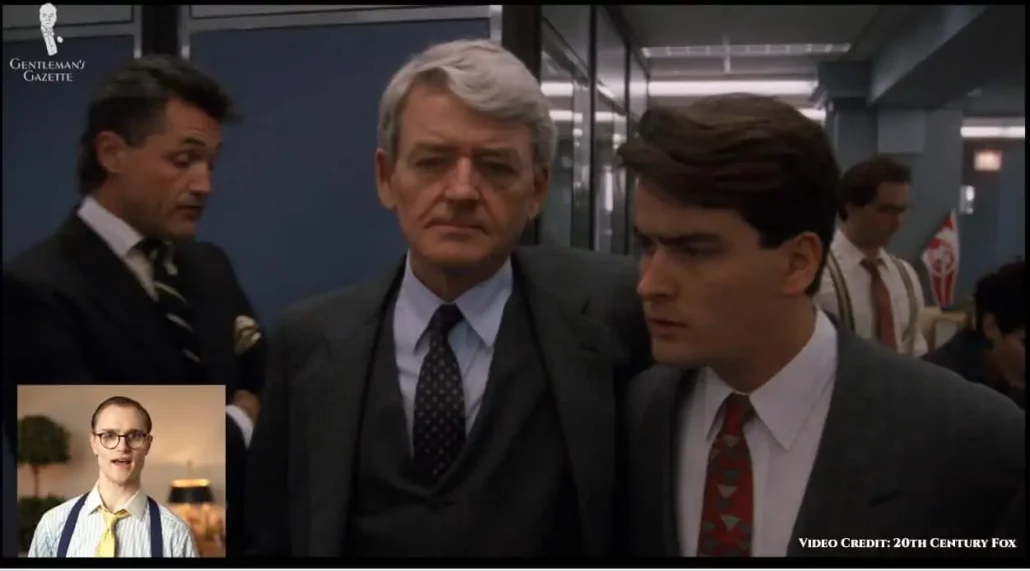
Later on, Fox does stay more classic in emulating Gekko’s watch. He opts for a square-faced Cartier Panthère with a gold bracelet, emulating Gekko’s Santos to some degree.
We don’t get a particularly good look at Fox’s shoes or really any character’s footwear in the film. But, we can surmise that he’s probably wearing dark office-appropriate Oxfords most of the time in colors like black, dark, brown, or oxblood.
His sunglasses, meanwhile, are easier to see and they appear to be Ray-Bans, possibly the model number 3447.
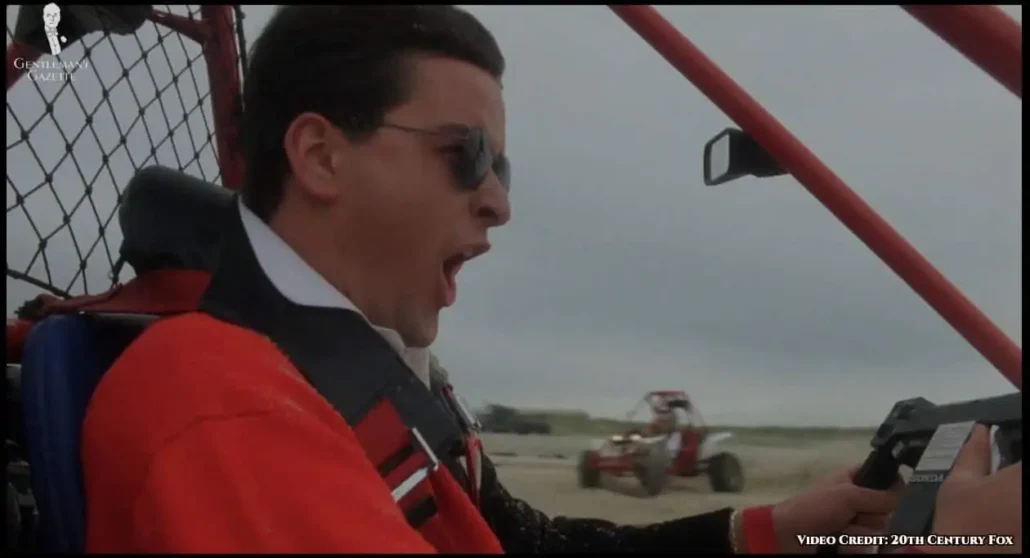
Of course, when Fox is finally caught and brought to trial at the tail end of the film, the flash and glitz in his style evaporate. At this point, we see him wearing a very dark gray and conservative single-breasted suit with notched lapels, a white shirt with a point collar, a dark purple tie, small silver cufflinks, and a black belt with silver hardware.
Note how, especially in these circumstances, silver appears much more sedate than gold.
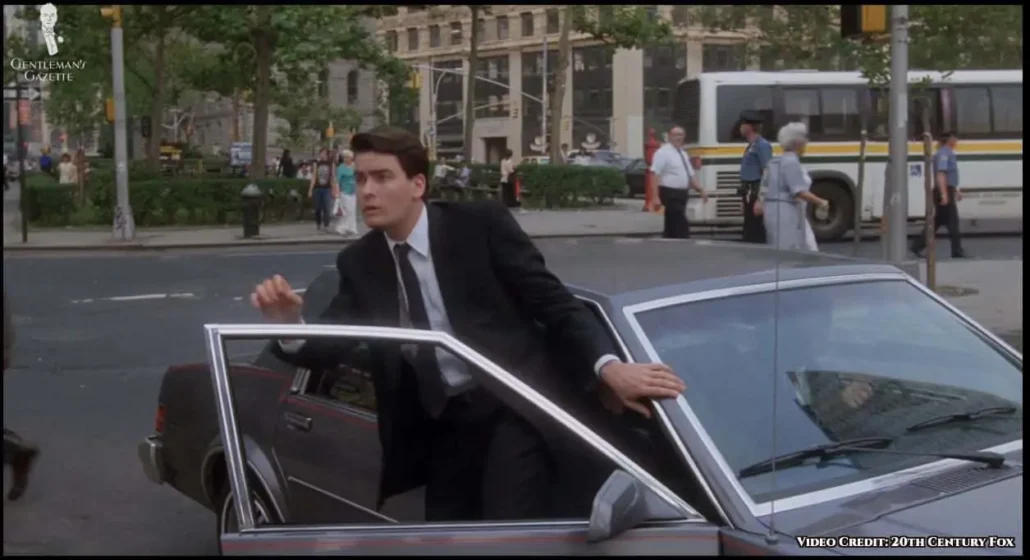
In this scene, of course, Fox is about to fight for his freedom, so he’s gone with a look that removes any trace of opulence. This is probably a good idea when one is trying to avoid charges of corruption.
During their final showdown in the film, both Fox and Gekko also wear trench coats, which were a popular lightweight outerwear option for men both then and now.
Overall, Bud Fox starts out as a caricature of low-level Wall Street brokers and, as the film goes on, he becomes a caricature of Gekko’s more opulent style.
A Roundup of Other Significant Characters & Styles
To round things out today, we’ll now give a brief rundown of some of the other characters and wardrobe features in the film to present a more holistic idea of the 80s fashions inside the movie.
Marv (John C. McGinley)
Fox’s friend, Marv, played by John C. McGinley wears a class ring, which was one of the most popular jewelry options for men in the mid-20th century and, also, a vintage or vintage-inspired pair of dark tortoiseshell eyeglasses.
We can also see a unique pair of vintage floating octagon eyeglasses worn by one of the government agents who arrests Fox near the end of the film.
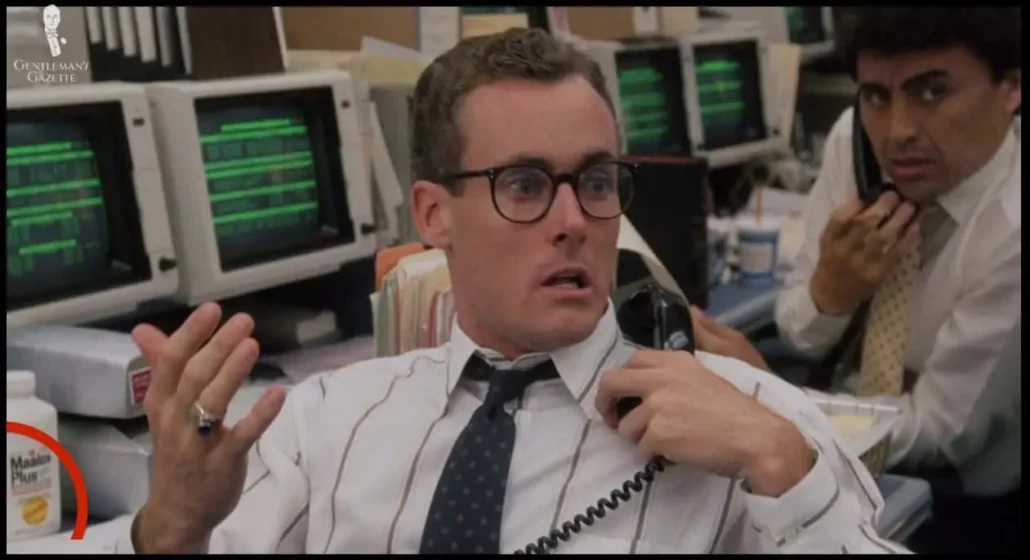
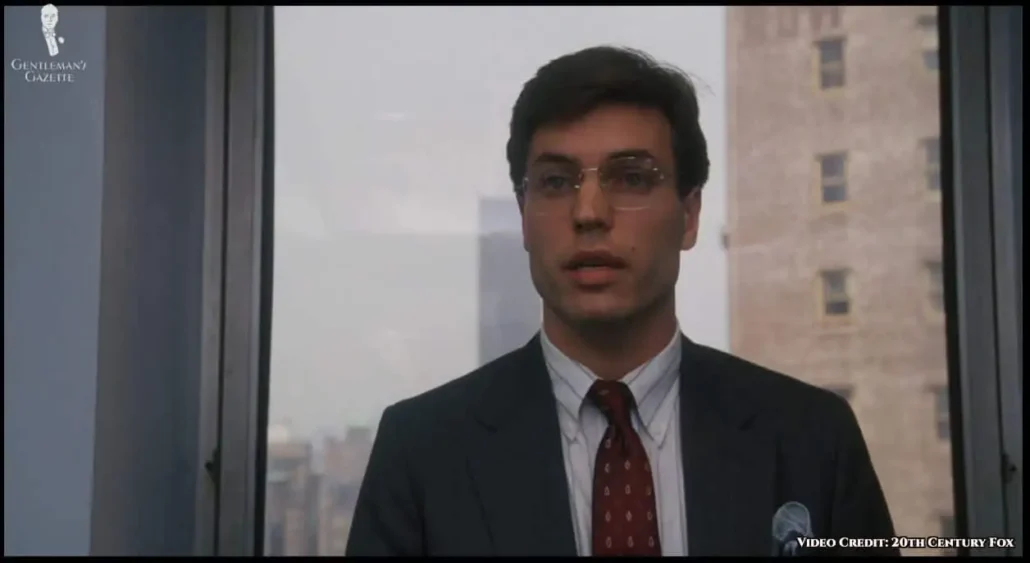
Lou Mannheim (Hal Holbrook)
One of Fox’s superiors, Lou Mannheim, played by Hal Holbrook, is an embodiment of the old-school with his conservative three-piece suits and snap-brim fedora. By 1985, of course, hats definitely on the way out as we discuss more comprehensively in a post about the decline of hat-wearing among men.
Mannheim also wears a hidden tie retainer, which is designed to keep one’s tie in place without any decorative elements. These tie retainers or tie straps can come in handy, but they can also make things look a bit odd when you’re not wearing a jacket.
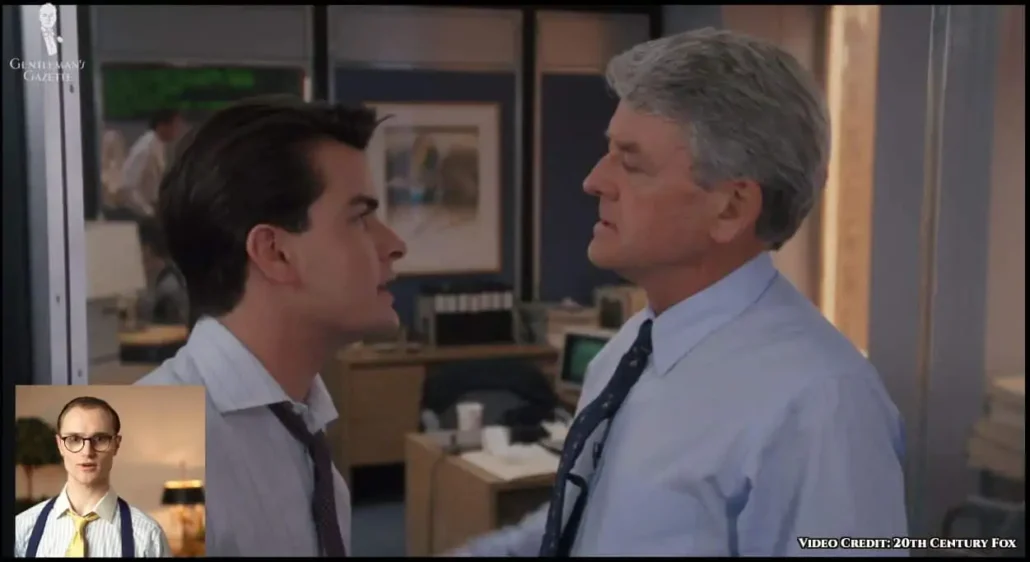
Ollie (Josh Mostel)
From Ollie, Gekko’s own personal stockbroker, we can see the neon flash of the early 80s. In general, we’re going to blame Miami Vice for looks like this.
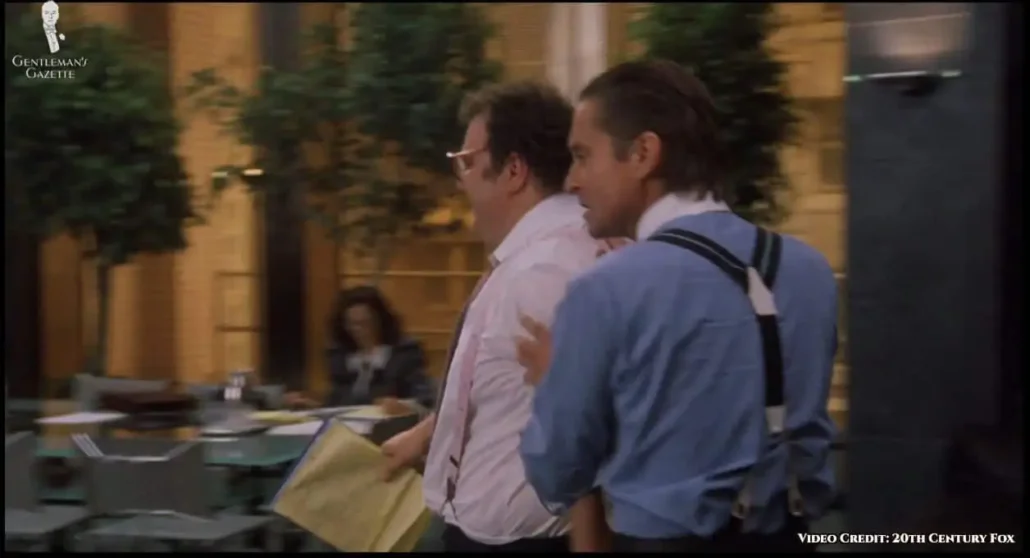
Dan (Franklin Cover)
From another stockbroker and co-worker of Fox’s, we’re given some hints on what not to wear. The broken-down failure Dan, played by Franklin Cover, is often shown wearing an oversized red boutonniere.
Boutonnieres had already largely fallen out of favor by the 1980s and, indeed, this one is so comically large that it makes Dan look mostly like the sad clown that he is.
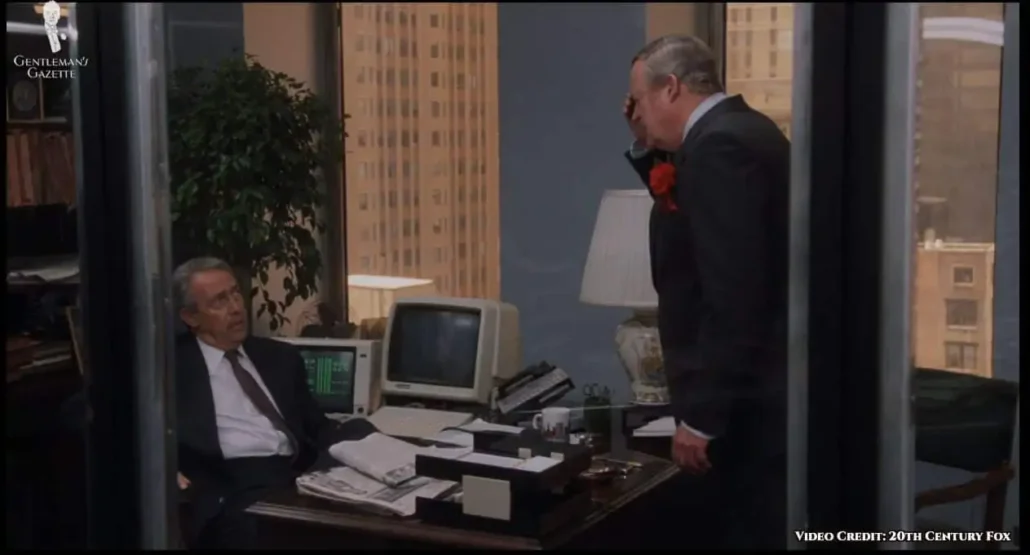
Of course, we here at the Gentleman’s Gazette and Fort Belvedere are big fans of boutonnieres, and we offer them in many sizes so that they’ll always harmonize perfectly with your lapel and not dominate your look.
Conclusion
According to director Oliver Stone, the scenes of the New York Stock Exchange were shot with real stockbrokers and, through them, we can see some fashions that didn’t make it into the ensembles of the main characters like bow ties, floral ties, and tan and beige suits.
So, when it comes to depicting the menswear looks of the time, how did Wall Street do? Overall, its stock offers mixed performance. Its two principal characters represent Hollywood’s version of what financiers of the time would have been wearing.
Through things like high-contrast colors, built-up silhouettes, and glittering accessories, what we’re seeing here is Flusser’s amplified depictions of 80s Wall Street fashions. As we mentioned before, relatively few Wall Street figures actually dressed like this before the film’s debut. But, afterward, its iconic looks influenced how men on Wall Street would dress for years and decades to come.
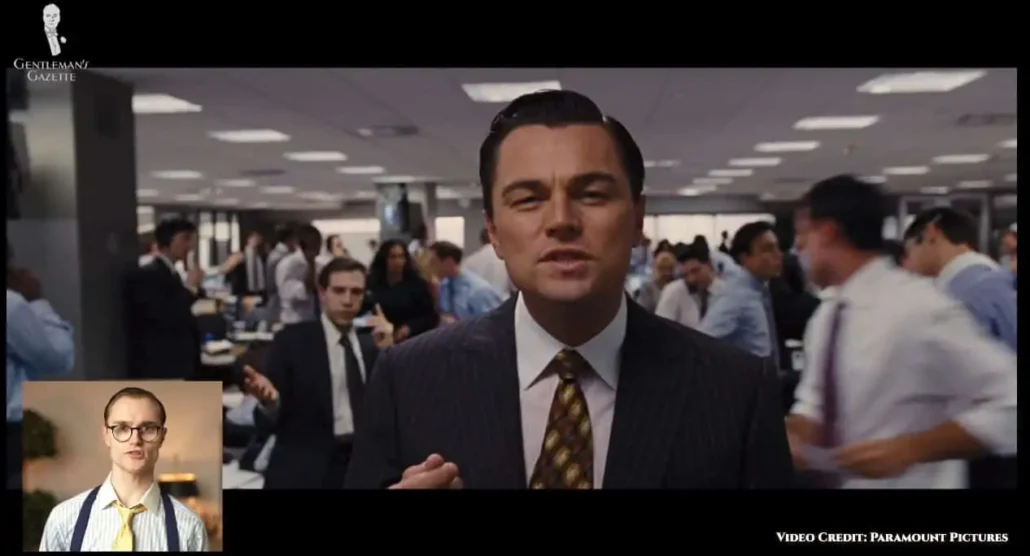
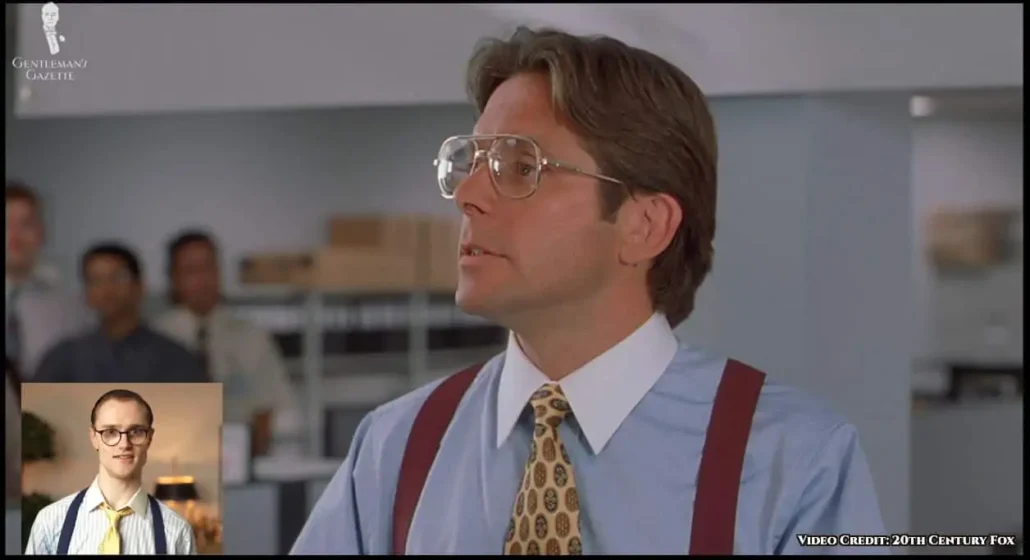
These looks would also permeate other aspects of culture in both real life and film and, as an example, you can look at the character of Bill Lumbergh in the 1999 film Office Space. In his style choices, he’s essentially Gordon Gekko minus the confidence and panache and, as a result, he definitely looks the part of the late-20th century middle-management figure.
So, Wall Street was inspired by contemporary styles and also inspired new styles of its own. This is a fairly impressive accomplishment and it’s the main reason why we wanted to highlight the film in our series. If you’d like to emulate any of these looks, we hope we’ve provided a good base for you. But, I’ll let Gordon Gekko take it from here:
“You done good, but you gotta keep doing good. I showed you how the game works. Now, school’s out.”
Gordon Gekko
Outfit Rundown
Today, I’m wearing an outfit that is directly meant to emulate some of the styles featured in the film. I’ve gone without a jacket today to show off some navy blue suspenders, and they’re worn over a Winchester shirt featuring a pattern of broad light blue and white stripes. Both the collar and French cuffs of the shirt are in contrasting white. And, for the cufflinks, I’ve gone with a vintage octagonal pair featuring a yellow and blue enameled design.
My bold silk tie features woven medallions in white and a bluish-green color over a yellow ground. I’m also wearing a simple gold tie bar at a slight angle to directly emulate Gordon Gekko. My shirt collar is unbuttoned and my tie is loosely knotted to emulate that busy broker look.
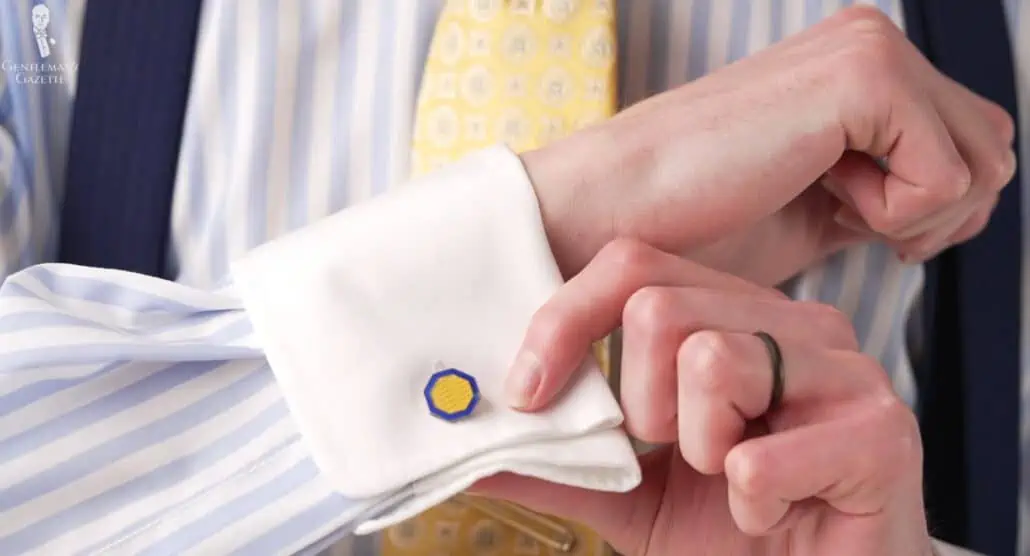
My trousers are part of a suit, which does date to the 1980s, and they feature a fairly generous double-pleated cut. They’re in a dark charcoal brown and feature a fine-striped pattern in tan and light blue. My shoes are medium brown Oxfords from Allen Edmonds in a conservative style, and my socks are from Fort Belvedere in navy blue featuring clock patterns in blue and white.
And, of course, to fully complete the look today, I’ve also attempted to slick my hair straight back a la Gordon Gekko, instead of my more typical side part. By the way, you can find the socks I’m wearing, as well as a wide variety of other classic men’s accessories and ones more tasteful than those worn in the “Wall Street” film by visiting the Fort Belvedere shop.
